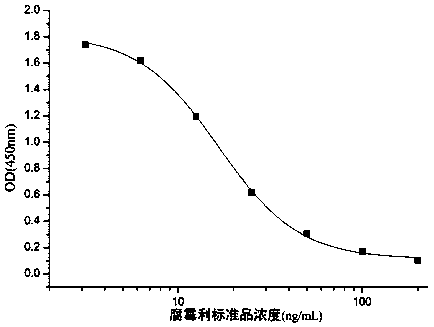Hybridoma cell strain secreting procymidone monoclonal antibody and application of procymidone monoclonal antibody
A hybridoma cell line and monoclonal antibody technology, which is applied in the direction of analytical materials, biochemical equipment and methods, and material inspection products, can solve the problems of long detection time, complicated processing, and inapplicability to rapid detection of a large number of samples, and achieve good results. Effect of Assay Sensitivity and Specificity
- Summary
- Abstract
- Description
- Claims
- Application Information
AI Technical Summary
Problems solved by technology
Method used
Image
Examples
Embodiment 1
[0043] Example 1: Synthesis of Procymidone Hapten
[0044] Since the small molecule of procymidone is not immunogenic and cannot stimulate the mice to produce an immune response and then produce antibodies, it is necessary to couple procymidone to the protein through protein linkage technology to obtain immunogenicity; protein coupling Active groups commonly used in technology include amino group, carboxyl group, hydroxyl group, mercapto group, etc. Since the molecular structure of procymidone does not contain these active groups, it needs to be derivatized.
[0045] The derived procymidone hapten structure of the present invention is as follows:
[0046] .
Embodiment 2
[0047] Example 2: Synthesis of Procymidone Complete Antigen
[0048] Weigh 2.0mg procymidone hapten (PRM-COOH), 2.1mg N-hydroxysuccinimide (NHS), dissolve in 300μL N,N-dimethylformamide (DMF), stir at room temperature for 10min; then Weigh 3.4 mg of 1-(3-dimethylaminopropyl)-3-ethylcarbodiimide hydrochloride (EDC), fully dissolve it in 100 μL DMF, add it to the PRM-COOH solution, and stir at room temperature to react 6 -8 h (called liquid A). Take 8mg KLH, dilute it to 4mg / mL with 0.01M carbonate buffer solution (CBS) (called solution B), then slowly add solution A to solution B drop by drop, react at room temperature overnight; then use 0.01M PBS solution Dialyzed to remove unreacted small molecular haptens, to obtain the complete antigen PRM-COOH-KLH, and identified by UV absorption scanning method.
Embodiment 3
[0049] Embodiment 3: the synthesis of procymidone coating former
[0050] Dissolve 2.2 mg of procymidone hapten (PRM-COOH) and 2.3 mg of N-hydroxysuccinimide (NHS) in 300 μL of anhydrous N,N-dimethylformamide (DMF), and stir at room temperature for 10 minutes to obtain Procymidone hapten (PRM-COOH) solution; after dissolving 3.8mg of 1-(3-dimethylaminopropyl)-3-ethylcarbodiimide hydrochloride (EDC) in 100μL of anhydrous DMF, add Add it to the PRM-COOH solution, stir at room temperature for 6-8 hours to obtain liquid A; dilute 10 mg of chicken ovalbumin (OVA) with 1 mL of carbonate buffer solution (CBS) with a concentration of 0.01 mmol / L to obtain liquid B; Slowly add solution A to solution B drop by drop for reaction to obtain a reaction solution; dialyze the reaction solution with PBS solution to remove unreacted small molecule haptens to obtain the original coating (PRM-COOH-OVA).
PUM
| Property | Measurement | Unit |
|---|---|---|
| Ic50 value | aaaaa | aaaaa |
Abstract
Description
Claims
Application Information
 Login to View More
Login to View More - R&D
- Intellectual Property
- Life Sciences
- Materials
- Tech Scout
- Unparalleled Data Quality
- Higher Quality Content
- 60% Fewer Hallucinations
Browse by: Latest US Patents, China's latest patents, Technical Efficacy Thesaurus, Application Domain, Technology Topic, Popular Technical Reports.
© 2025 PatSnap. All rights reserved.Legal|Privacy policy|Modern Slavery Act Transparency Statement|Sitemap|About US| Contact US: help@patsnap.com

